Technical Data Top chain Selection
The latter half of this page also introduces the following selection examples:
Click on each item to scroll to the main text.
- *WT0700 series Selection example
- *WT1500 series, WT1510 series and BTN5 Selection example
- *WT2525VG-K Selection example
- *WT1515F-W, WT1516F-W Selection example
- *WT3816-K Selection example
Plastic modular chain (Wide type) Selection example
Steps 1. Check Conveyance Conditions
- ・Conveyor width ...Approximately 600 mm
- ・Conveyor length ...10m
- ・Conveying speed ...20m/min
- ・Conveyed object ...350 ml can filled with contents (98kg/m2)
- ・Accumulate ...Fully accumulated on conveyor
- ・Temperature ...Ambient Temperature
- ・Lubrication ...Soapy water
Steps 2. Select Top Plate Material and Chain Type
BTO6-6096-LFB (open type, LFB series) is selected.
(BTO6-6096-LFB)
Steps 3. Select Wearstrip Material
UHMW-PE is selected.
(BTO6-6096-LFB)
Steps 4. Calculate Chain Tension and Power Required
- m1=Chain mass ...4kg/m
For a chain width of 609.6 mm
6.56(catalog value kg/m2)× 609.6/1000 ≒ 4(kg/m) - S1=Length of conveying portion ...0m
- m2=Mass of conveyed objects in conveying portion ...0kg/m
- S2=Length of accumulating portion ...10m
- m3=Mass of conveyed objects in accumulating portion ...60kg/m
For a chain width of 609.6 mm
98(conditions as above in kg/m2) × 609.6/1000 ≒ 60(kg/m) - μ1=Coefficient of dynamic friction between chain and wearstrip ...0.13(See Table 2 )
- μ2=Coefficient of friction between chain and conveyed objects during accumulation ...0.13(See Table 2 )
- V=Chain speed ...20m/min
- η=Transmission efficiency of drive unit ...0.8
SI Unit (kN)
F = 9.80665 × 10-3 × {(2.1 × 4 + 0) × 0 × 0.13
+ (2.1 × 4 + 60) × 10 × 0.13 + 60 × 10 × 0.13} = 1.64kN
P = 1.64 × 20 60 × 0.8 = 0.683kW
Gravity unit
F = (2.1 × 4 + 0) × 0 × 0.13 + (2.1 × 4 + 60) × 10 × 0.13
+ 60 × 10 × 0.13 = 166.9kgf
P = 166.9 × 20 6120 × 0.8 = 0.682kW
Steps 5. Determine Chain Model and Chain Width
Tension applied per 1 meter of chain width
F' =
1000 × 1.64
609.6
= 2.69kN/m {274kgf/m}
Since the above value exists below the appropriate line in the allowable load graphs can be used. (Refer to the allowable load graphs on product page.)

Steps 6. Select sprockets, shafts, and bearing units
Select sprockets, shafts, and bearing units
Bearing support span = Chain width (610) + 150 = 760mm
In accordance with “the tension applied per 1 meter of chain width (F')”, “the bearing support span graph”, and tables 13, 37, and 38 (Type of Shafts and Corresponding Bearing Units), one of the following combinations of shaft and bearing unit should be used.
10T 38 hexagonal shaft Bearing unit φ25 to φ35
or
24T 40 square shaft Bearing unit φ30 to φ35
is to be used.
Steps 7. Calculate Chain Tension and Power Required
1) Chain tension rate F1 (%) verification
F1 = 100 × 2.69 12.8 = 21.0%
2) Determine sprocket locations
Since F1 is 50% or less, the sprockets should be installed with a center distance as shown below. (Refer to the section 4-3 (8)).
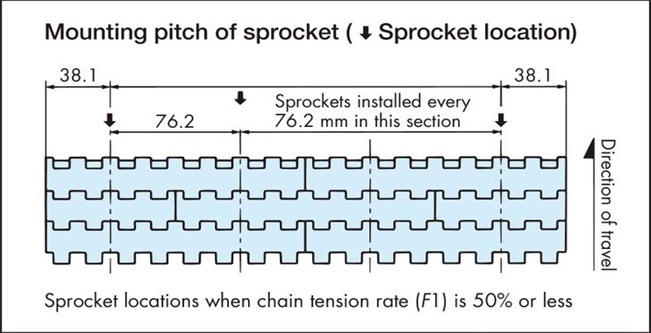
WT0700 series Selection example
Nose bar on driven side
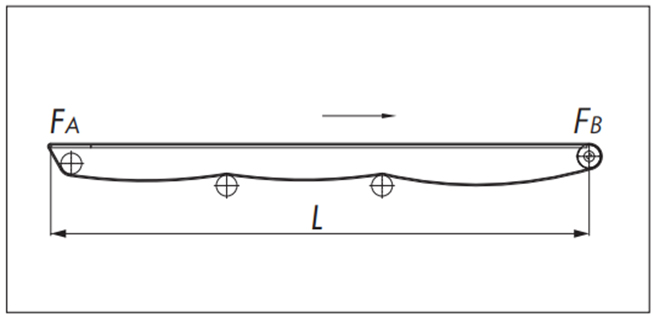
●Calculation formula (SI units: kN)
・Tension at return-way
[Tension at section A :FA]
FA = m1・L・μ1・fn × 9.80665 × 10-3
・Tension at carry-way
[Tension at section B :FB]
FB = FA + {(m1 + m2) L・μ1 + m2・LS・μ2} × 9.80665 × 10-3
・Chain load
F = FB
Note: LS = 0 when there is no accumulation of conveyed products.
●Calculation example (SI units)
| Usage conditions | |
|---|---|
| Chain model | WT0705-W300-LFG (m1=5.9×0.3=1.77kg/m) |
| Chain width | 300mm |
| Layout | L=2m |
| Chain speed | V=15m/min |
| Conveyed object | 500-ml aluminum can (filled) |
| Conveyed product mass (per 1-meter unit of length) | m2=139kg/m2(523 g/piece ) ×0.3m=41.7kg/m |
| Rail | UHMW-PE (Plastic rail) |
| Accumulation distance | Ls=2m |
| Lubrication | For dry conditions |
| Operating Ambient Temperature | 20℃ |
| Coefficient of dynamic friction between chain and wearstrip | μ1=0.2 |
| Dynamic coefficient of friction between chain and conveyed product | μ2=0.2 |
| Nose bar coefficient | fn=1.8 |
・Tension at return-way
[Tension at section A :FA]
FA = 1.77 × 2 × 0.2 × 1.8 × 9.80665 × 10-3 = 0.0125kN
・Tension at carry-way
[Tension at section B :FB]
FB = 0.0125 + {(1.77 + 41.7) × 2 × 0.2 + 41.7 × 2 × 0.2} × 9.80665 × 10-3 = 0.35kN
・Determine acceptability
Max. allowable load ≧FB'
Converted to per meter of chain width
FB' = 1000 × FB 300 = 1.17(kN/m)
From the allowable load graph, maximum allowable tension is 2.5 (kN/m).
2.5(kN/m)≧1.17(kN/m)
Selected chain is acceptable.
Nose bar on front end
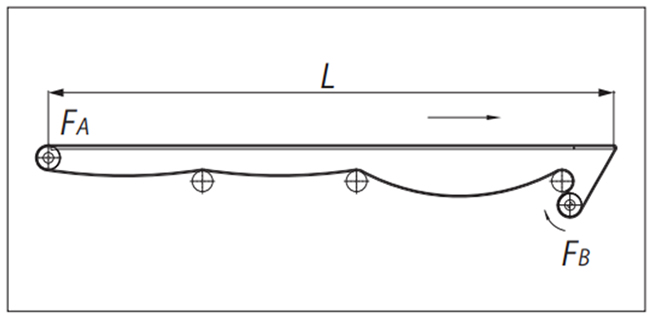
●Calculation formula (SI units: kN)
・Tension at return-way
[Tension at section A :FA]
FA = 1.1m1・L・μ1 × 9.80665 × 10-3
・Tension at carry-way
[Tension at section B :FB]
FB= [FA + {(m1 + m2) L・μ1 + m2・LS・μ2} × 9.80665 × 10-3] × fn
・Chain load
F = FB
Note: LS = 0 when there is no accumulation of conveyed products.
●Calculation example (SI units)
| Usage conditions | |
|---|---|
| Chain model | WT0705-W300-LFG (m1=5.9×0.3=1.77kg/m) |
| Chain width | 300mm |
| Layout | L=2m |
| Chain speed | V=15m/min |
| Conveyed object | 500-ml aluminum can (filled) |
| Conveyed product mass (per 1-meter unit of length) | m2=139kg/m2(523 g/piece ) ×0.3m=41.7kg/m |
| Rail | UHMW-PE (Plastic rail) |
| Accumulation distance | Ls=2m |
| Lubrication | For dry conditions |
| Operating Ambient Temperature | 20℃ |
| Coefficient of dynamic friction between chain and wearstrip | μ1=0.2 |
| Dynamic coefficient of friction between chain and conveyed product | μ2=0.2 |
| Nose bar coefficient | fn=1.8 |
・Tension at return-way
[Tension at section A :FA]
FA = 1.1 × 1.77 × 2 × 0.2 × 9.80665 × 10-3 = 0.0077kN
・Tension at carry-way
[Tension at section B :FB]
FB = [0.0077 + {(1.77 + 41.7) × 2 × 0.2 + 41.7 × 2 × 0.2} × 9.80665 × 10-3] × 1.8 = 0.62kN
・Determine acceptability
Max. allowable load ≧FB'
Converted to per meter of chain width
FB' = 1000 × FB 300 = 2.07(kN/m)
From the allowable load graph, maximum allowable tension is 2.5 (kN/m).
2.5(kN/m)≧2.07(kN/m)
Selected chain is acceptable.
Nose bar on both ends
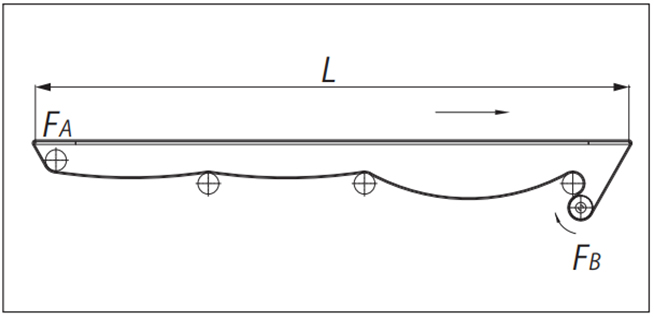
●Calculation formula (SI units: kN)
・Tension at return-way
[Tension at section A :FA]
FA = m1・L・μ1・fn × 9.80665 × 10-3
・Tension at carry-way
[Tension at section B :FB]
FB= [FA + {(m1 + m2) L・μ1 + m2・LS・μ2} × 9.80665 × 10-3] × fn
・Chain load
F = FB
Note: LS = 0 when there is no accumulation of conveyed products.
●Calculation example (SI units)
| Usage conditions | |
|---|---|
| Chain model | WT0705-W300-LFG (m1=5.9×0.3=1.77kg/m) |
| Chain width | 300mm |
| Layout | L=2m |
| Chain speed | V=15m/min |
| Conveyed object | 500-ml aluminum can (filled) |
| Conveyed product mass (per 1-meter unit of length) | m2=139kg/m2(523 g/piece ) ×0.3m=41.7kg/m |
| Rail | UHMW-PE (Plastic rail) |
| Accumulation distance | Ls=2m |
| Lubrication | For dry conditions |
| Operating Ambient Temperature | 20℃ |
| Coefficient of dynamic friction between chain and wearstrip | μ1=0.2 |
| Dynamic coefficient of friction between chain and conveyed product | μ2=0.2 |
| Nose bar coefficient | fn=1.8 |
・Tension at return-way
[Tension at section A :FA]
FA = 1.77 × 2 × 0.2 × 1.8 × 9.80665 × 10-3 = 0.0125kN
・Tension at carry-way
[Tension at section B :FB]
FB = [0.0125 + {(1.77 + 41.7) × 2 × 0.2 + 41.7 × 2 × 0.2} × 9.80665 × 10-3] × 1.8 = 0.63kN
・Determine acceptability
Max. allowable load ≧FB'
Converted to per meter of chain width
FB' = 1000 × FB 300 = 2.1(kN/m)
From the allowable load graph, maximum allowable tension is 2.5 (kN/m).
2.5(kN/m)≧2.1(kN/m)
Selected chain is acceptable.
fn(Nose bar coefficient )
| Lubrication | Nose bar coefficient fn |
|---|---|
| Sliding Series | |
| For dry conditions | 1.8 |
| Soapsuds | 1.35 |
WT1500 series, WT1510 series and BTN5 Selection example
Nose bar on driven side
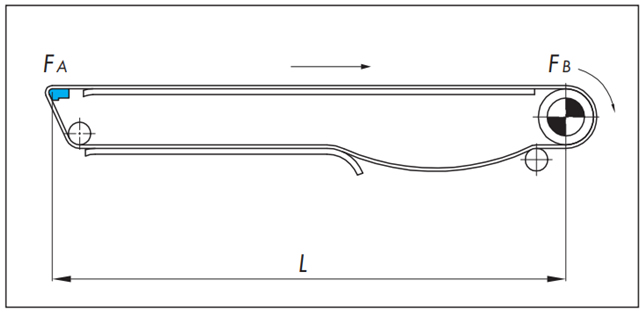
●Calculation formula (SI units: kN)
・Tension at return-way
[Tension at section A :FA]
FA = m1・L・μ1・fn × 9.80665 × 10-3
・Tension at carry-way
[Tension at section B :FB]
FB = FA + {(m1 + m2) L・μ1 + m2・LS・μ2} × 9.80665 × 10-3
・Chain load
F = FB
Note: LS = 0 when there is no accumulation of conveyed products.
●Calculation example (SI units)
| Usage conditions | |
|---|---|
| Chain model | WT1506-K30-ALF (m1=6.7×0.762=5.1kg/m) |
| Chain width | 762mm |
| Layout | L=4m |
| Chain speed | V=15m/min |
| Conveyed object | 500-ml aluminum can (filled) |
| Weight of conveyed goods (per 1-meter unit of length ) | m2=139kg/m2(523 g/piece ) ×0.762m=106kg/m |
| Rail | Ultra high molecular weight polyethylene (Plastic rail ) |
| Accumulation distance | Ls=4m |
| Lubrication | For dry conditions |
| Operating Ambient Temperature | 20℃ |
| Coefficient of dynamic friction between chain and wearstrip | μ1=0.15 |
| Dynamic coefficient of friction between chain and conveyed product | μ2=0.14 |
| Nose bar coefficient | fn=1.35(bearing/roller type ) |
・Tension at return-way
[Tension at section A :FA]
FA = 5.1 × 4 × 0.15 × 1.35 × 9.80665 × 10-3 = 0.04kN
・Tension at carry-way
[Tension at section B :FB]
FB = 0.04 + {(5.1 + 106) × 4 × 0.15 + 106 × 4 × 0.14} × 9.80665 × 10-3 = 1.28kN
・Determine acceptability
Max. allowable load ≧FB'
Converted to per meter of chain width
FB' = 1000 × FB 762 = 1.68(kN/m)
From the allowable load graph, maximum allowable tension is 10.5 (kN/m).
10.5(kN/m)≧1.68(kN/m)
Selected chain is acceptable.
Nose bar on front end
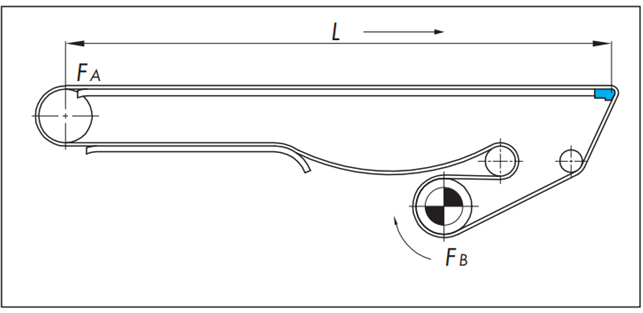
●Calculation formula (SI units: kN)
・Tension at return-way
[Tension at section A :FA]
FA = 1.1m1・L・μ1 × 9.80665 × 10-3
・Tension at carry-way
[Tension at section B :FB]
FB= [FA + {(m1 + m2) L・μ1 + m2・LS・μ2} × 9.80665 × 10-3] × fn
・Chain load
F = FB
Note: LS = 0 when there is no accumulation of conveyed products.
●Calculation example (SI units)
| Usage conditions | |
|---|---|
| Chain model | WT1506-K30-ALF (m1=6.7×0.762=5.1kg/m) |
| Chain width | 762mm |
| Layout | L=4m |
| Chain speed | V=15m/min |
| Conveyed object | 500-ml aluminum can (filled) |
| Weight of conveyed goods (per 1-meter unit of length ) | m2=139kg/m2(523 g/piece ) ×0.762m=106kg/m |
| Rail | Ultra high molecular weight polyethylene (Plastic rail ) |
| Accumulation distance | Ls=4m |
| Lubrication | For dry conditions |
| Operating Ambient Temperature | 20℃ |
| Coefficient of dynamic friction between chain and wearstrip | μ1=0.15 |
| Dynamic coefficient of friction between chain and conveyed product | μ2=0.14 |
| Nose bar coefficient | fn=1.35(bearing/roller type ) |
・Tension at return-way
[Tension at section A :FA]
FA = 1.1 × 5.1 × 4 × 0.15 × 9.80665 × 10-3 = 0.03kN
・Tension at carry-way
[Tension at section B :FB]
FB = [0.03 + {(5.1 + 106) × 4 × 0.15 + 106 × 4 × 0.14} × 9.80665 × 10-3] × 1.35 = 1.71kN
・Determine acceptability
Max. allowable load ≧FB'
Converted to per meter of chain width
FB' = 1000 × FB 762 = 2.24(kN/m)
From the allowable load graph, maximum allowable tension is 10.5 (kN/m).
10.5(kN/m)≧2.24(kN/m)
Selected chain is acceptable.
Nose bar on both ends
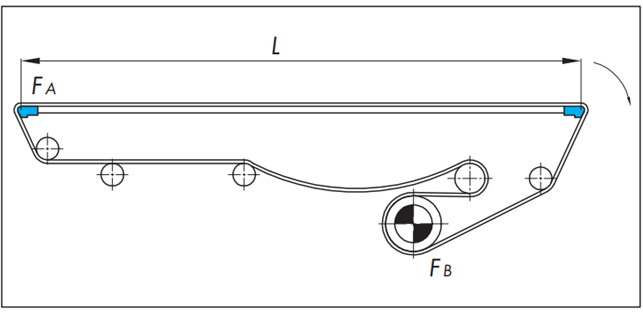
●Calculation formula (SI units: kN)
・Tension at return-way
[Tension at section A :FA]
FA = m1・L・μ1・fn × 9.80665 × 10-3
・Tension at carry-way
[Tension at section B :FB]
FB= [FA + {(m1 + m2) L・μ1 + m2・LS・μ2} × 9.80665 × 10-3] × fn
・Chain load
F = FB
Note: LS = 0 when there is no accumulation of conveyed products.
●Calculation example (SI units)
| Usage conditions | |
|---|---|
| Chain model | WT1506-K30-ALF (m1=6.7×0.762=5.1kg/m) |
| Chain width | 762mm |
| Layout | L=4m |
| Chain speed | V=15m/min |
| Conveyed object | 500-ml aluminum can (filled) |
| Weight of conveyed goods (per 1-meter unit of length ) | m2=139kg/m2(523 g/piece ) ×0.762m=106kg/m |
| Rail | Ultra high molecular weight polyethylene (Plastic rail ) |
| Accumulation distance | Ls=4m |
| Lubrication | For dry conditions |
| Operating Ambient Temperature | 20℃ |
| Coefficient of dynamic friction between chain and wearstrip | μ1=0.15 |
| Dynamic coefficient of friction between chain and conveyed product | μ2=0.14 |
| Nose bar coefficient | fn=1.35(nose bar/roller type ) |
・Tension at return-way
[Tension at section A :FA]
FA = 5.1 × 4 × 0.15 × 1.35 × 9.80665 × 10-3 = 0.04kN
・Tension at carry-way
[Tension at section B :FB]
FB = [0.04 + {(5.1 + 106) × 4 × 0.15 + 106 × 4 × 0.14} × 9.80665 × 10-3] × 1.35 = 1.72kN
・Determine acceptability
Max. allowable load ≧FB'
Converted to per meter of chain width
FB' = 1000 × FB 762 = 2.26(kN/m)
From the allowable load graph, maximum allowable tension is 10.5 (kN/m).
10.5(kN/m)≧2.26(kN/m)
Selected chain is acceptable.
fn(Nose bar coefficient )
| Lubrication | Nose bar coefficient fn | |
|---|---|---|
| Sliding Series | bearing/roller type | |
| For dry conditions | 1.8 | 1.35 |
| Soapsuds | 1.35 | |
WT2525VG-K Selection example
Forward/reverse bottom drive selection example

●Calculation formula (SI units: kN)
・Tension at return-way (Driven Side )
[Tension at section A :FA]
FA = 1.1m1・L1・μ1 × 9.80665 × 10-3
・Tension at carry-way
[Tension at section B :FB]
FB = 1.1{FA + (m1 + m2) × L・μ1 × 9.80665 × 10-3}
・Tension at return-way (drive )
[Tension at section C :FC]
FC = FB + m1・L2・μ1 × 9.80665 × 10-3
・Chain load
F = FC
●Calculation example (SI units)
| Usage conditions | |
|---|---|
| Chain model | WT2525VG-K36-G (m1=9.5×0.9144=8.7kg/m) |
| Chain width | 914.4mm |
| Layout | L=10m, L1=6m, L2=4m |
| Chain speed | V=10m/min |
| Conveyed object | cardboard sheet 900mm×1800mm×5mm 106.4kg/m2=861.8g/sheet x 200 sheets (height 1m) |
| Weight of conveyed goods (per 1-meter unit of length ) | m2=106.4kg/m2×0.9144m =97.3kg/m |
| Rail | Ultra high molecular weight polyethylene (Plastic rail ) |
| Lubrication | For dry conditions |
| Operating Ambient Temperature | 20℃ |
| Coefficient of dynamic friction between chain and wearstrip | μ1=0.25 |
・Tension at return-way (Driven Side )
[Tension at section A :FA]
FA = 1.1 × 8.7 × 6 × 0.25 × 9.80665 × 10-3 = 0.14kN
・Tension at carry-way
[Tension at section B :FB]
FB = 1.1 {0.14 + (8.7 + 97.3) × 10 × 0.25 × 9.80665 × 10-3} = 3.0kN
・Tension at return-way (drive )
[Tension at section C :FC]
FC = 3.0 + 8.7 × 4 × 0.25 × 9.80665 × 10-3 = 3.09kN
・Determine acceptability
Max. allowable load ≧FB'
Converted to per meter of chain width
FB' = 1000 × FB 914.4 = 3.34(kN/m)
From the allowable load graph, maximum allowable tension is 12.8 (kN/m).
12.8(kN/m)≧3.34(kN/m)
Selected chain is acceptable.
WT1515F-W, WT1516F-W Selection example
Calculating inclined movement (horizontal + inclined + horizontal)
Basically, it is the same as for inclined movement (inclined only). The tension acting on the curve part between horizontal and inclined is corrected using the angle coefficient.
A calculation example is shown for the conveyor route below.
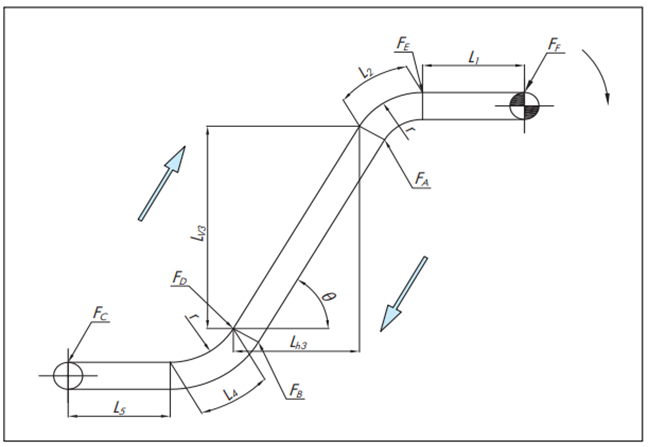
●Calculation formula (SI units: kN)
L2 = r × αS L4 = r × αS
・Tension at return-way
[Tension at section A :FA]
FA = m1(L1 + L2) μ1・αL × 9.80665 × 10-3
L2 = r × αS
[Tension at section B :FB]
FB = FA + m1(Lh3・μ1 - Lv3) × 9.80665 × 10-3
If FB < 0, FB = 0
[Tension at section C :FC]
FC = 1.1 × (FB + m1(L4 + L5)) × 9.80665 × 10-3・αL
L4 = r × αS
・Tension at carry-way
[Tension at section D :FD]
FD = {FC + (m1 + m2)(L4 + L5) μ1} × 9.80665 × 10-3・αL
L4 = r × αS
[Tension at section E :FE]
FE = FD + (m1 + m2)(Lh3・μ1 + Lv3) × 9.80665 × 10-3
[Tension at section F :FF]
FF = {FE + (m1 + m2)(L1 + L2) μ1} × 9.80665 × 10-3・αL
L2 = r × αS
・Chain load
F = FF
Force acting on float-preventive attachment (tab)
When attaching a float-preventive attachment (tab) to a chain, calculate the force Ft applied to one float-preventive attachment (tab).
The chain floats on the curve part between horizontal and inclined. The floating force is maximum in the L4 part.
Ft = FD sin θ/2 nt × 1000
nt = Total number of float-preventive attachments (tabs) in L4 section
nt = L4 30 × (Formation points of tabs in the chain width direction )
Can be used if the force Ft applied to one float-preventive attachment (tab) is 240 N or less.
Ft < 240N
●Calculation example (SI units)
| Usage conditions | |
|---|---|
| Chain model | WT1515T-F-W400-LFG-10L-FM50N2 (m1=6.7×0.4=2.7kg/m) |
| Chain width | 400mm |
| Layout | L1=0.7m Lv3=1.5m Lh3=0.866m L5=0.7m From r=0.5m and angle 60°, length factor αs=1.0 L2=L4=0.5×1.0=0.5m (Total lift 2m) |
| Inclination angle | θ=60° |
| Chain speed | V=9m/min |
| Conveyed object | Aluminum parts, 20mm cube, 120 pieces to be scraped in one place |
| Conveyed product mass (per 1-meter unit of length) | m2=30kg/m2(15g/piece )×0.4m =12kg/m |
| Rail | Ultra high molecular weight polyethylene (Plastic rail ) |
| Accumulation distance | Ls=4m |
| Lubrication | For dry conditions |
| Operating Ambient Temperature | 20℃ |
| Coefficient of dynamic friction between chain and wearstrip | μ1=0.2 (Angle factor αL=1.25) |
・Tension at return-way
[Tension at section A :FA]
FA = 2.7 (0.7 + 0.5) 0.2 × 1.25 × 9.80665 × 10-3
[Tension at section B :FB]
FB = 0.0079 + 2.7 (0.866 × 0.2 - 1.5) × 9.80665 × 10-3 = -0.027kN
From FB < 0, FB = 0kN
[Tension at section C :FC]
FC= 1.1 × (0 + 5.1(0.5 + 0.7)) 1.25 × 9.80665 × 10-3・αL = -0.083kN
・Tension at carry-way
[Tension at section D :FD]
FD={0.083 + (2.7 + 12)(0.5 + 0.7) 0.2 × 9.80665 × 10-3} × 1.25 = 0.15kN
[Tension at section E :FE]
FE = 0.15 + (2.7 + 12)(0.866 × 0.2 + 1.5) × 9.80665 × 10-3 = 0.39kN
[Tension at section F :FF]
FF = {0.39 + (2.7 + 12)(0.7 + 0.5) 0.2 × 9.80665 × 10-3・αL = 0.53kN
・Chain load
F = 0.53kN
・Determine acceptability
Max. allowable load ≧ F
F' = 1000 × F 400 = 1.3(kN/m)
From the allowable load graph, maximum allowable tension is 10.5 (kN/m).
10.5(kN/m)≧1.3(kN/m)
Selected chain is acceptable.
・Force acting on float-preventive attachment (tab)
Ft = 0.15 × sin(60/2) 13 × 1000 = 5.8kN
nt = 400 30 = 13 places
Since the force applied to one float preventive attachment (tab) is 5.8N, 5.8N <240N, it can be used.
WT3816-K Selection example
Special conveyors (pasteurizers, warmers, coolers)
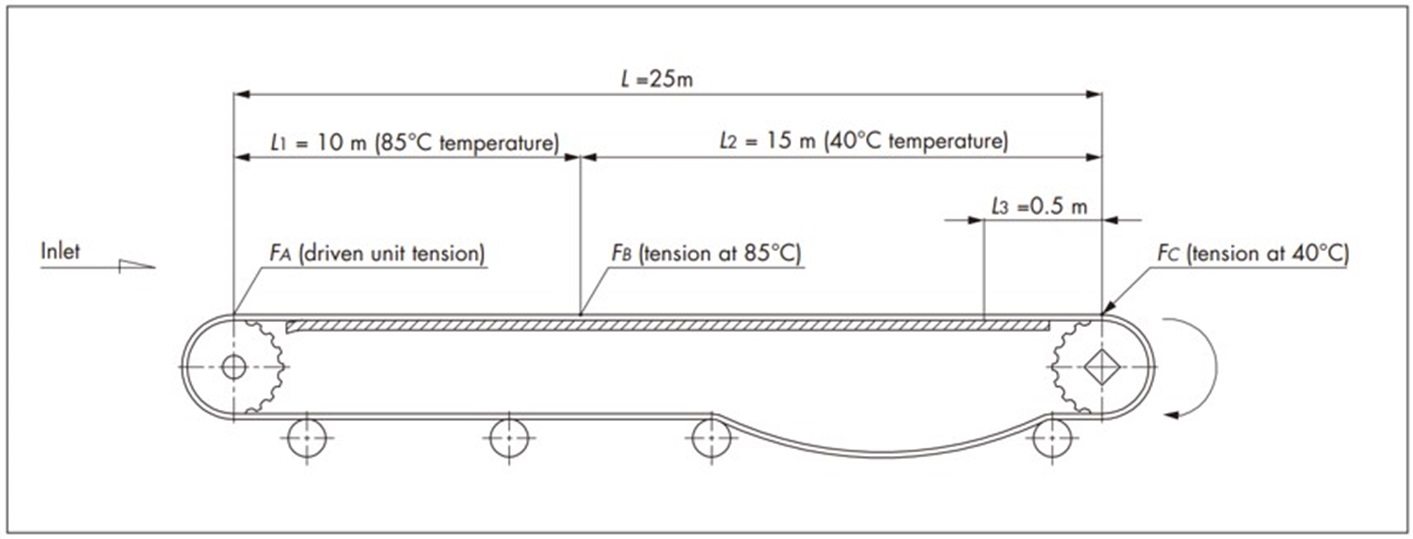
●Calculation formula (SI units: kN)
・Tension at return-way
[Tension at section A :FA]
FA = 1.1m1・L・μ1 × 9.80665 × 10-3
・Tension at carry-way
[Tension at section B :FB]
FB = FA + (m1 + m2) L1・μ1 × 9.80665 × 10-3
[Tension at section C :FC]
FC = FB + {(m1 + m2) L2・μ1 + m2・L3・μ2} × 9.80665 × 10-3
●Calculation example (SI units)
| Usage conditions | |
|---|---|
| Chain model | WT3816-K2000-HTW (m1=9.8×2=19.6kg/m) |
| Chain width | 2000mm |
| Layout | L=25m, L1=10m, L2=15m |
| Chain speed | V=1m/min |
| Conveyed object | 1,500-ml PET bottle |
| Conveyed product mass (per 1-meter unit of length) | m2=200kg/m2(1530 g/piece )×2m =400kg/m |
| Rail | Stainless steel (polished) |
| Accumulation distance | L3=0.5m |
| Lubrication | Water (hot water) |
| Operating Ambient Temperature | Hot water (85˚C max. ) |
| Coefficient of dynamic friction between chain and wearstrip | μ1=0.35 |
| Dynamic coefficient of friction between chain and conveyed product | μ2=0.35 |
・Tension at return-way
[Tension at section A :FA]
FA = 1.1 × 19.6 × 25 × 0.35 × 9.80665 × 10-3 = 1.85kN
・Tension at carry-way
[Tension at section B :FB]
FB = 1.85 + (19.6 + 400) × 10 × 0.35 × 9.80665 × 10-3 = 16.3kN
[Tension at section C :FC]
FC = 16.3 + {(19.6 + 400) × 15 × 0.35 + 400 × 0.5 × 0.35} × 9.80665 × 10-3 = 38.6kN
・Determine acceptability
A determination is made for each temperature range
Max. allowable load ≧ F
・At 85°C
Working tension F = FB'
Converted to per meter of chain width
FB' = 1000 × FB 2000 = 8.15(kN/m)
From the allowable load graph, maximum allowable tension at 85°C is 8.3 (kN/m).
8.3(kN/m)≧8.15(kN/m)
Selected chain is acceptable.
・At 40°C
Working tension F = FC'
Converted to per meter of chain width
FC' = 1000 × FC 2000 = 19.3(kN/m)
From the allowable load graph, maximum allowable load at 40°C is 20 (kN/m).
20(kN/m)≧19.3(kN/m)
Selected chain is acceptable.
Selected chain can be used in each temperature range.

